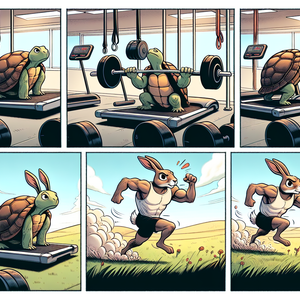Hacking Personal Branding with Tech: Stand Out in the Digital Era

Personal branding is your professional fingerprint—it’s how you present yourself to the world and communicate your unique value. Whether you’re a freelancer, entrepreneur, or corporate professional, your brand is often the first impression you make on clients, employers, or collaborators. A strong personal brand builds trust, establishes credibility, and signals your expertise. However, in today’s digital-first era, standard efforts like updating your résumé or adding a professional headshot to LinkedIn won’t suffice. The competition is fierce, and standing out requires more than just checking boxes. By leveraging innovative tech tools and platforms, you can elevate your personal brand to a whole new level, positioning yourself as a forward-thinking leader in your field.
Hack #1: Gamify Your Digital Presence with Interactive Portfolios
Static résumés and portfolios are outdated. Instead, consider transforming your professional story into an engaging, interactive experience. Tools like Genially and Visme allow you to build gamified portfolios that invite viewers to actively explore your skills and achievements. For instance, imagine creating a résumé where recruiters can "choose their own adventure." They could click on different elements of your career history, uncover testimonials, watch embedded videos of your work, or even discover hidden Easter eggs that highlight your creativity. If you’re a graphic designer, a gamified portfolio could include a clickable gallery of your best work. If you’re a marketing professional, you might create an interactive timeline of successful campaigns you’ve led. Gamification not only makes you memorable but also demonstrates your tech-savviness and creative approach.
Hack #2: Use AI for Personalized Content Creation
Artificial intelligence (AI) is revolutionizing content creation, making it easier than ever to maintain a consistent and professional brand voice. Tools like ChatGPT, Writesonic, and Jasper can help you craft blog posts, social media captions, and even video scripts that align with your personal branding goals. But AI’s potential doesn’t stop at text. AI-powered graphic tools like Canva’s Magic Design and Runway ML enable you to create stunning visuals, animations, and presentations without requiring advanced design skills. For example, if you’re an entrepreneur, you could use AI to generate a weekly newsletter that shares industry insights, paired with custom-designed infographics to visually communicate your expertise. By consistently sharing high-quality, branded content, you’ll position yourself as a thought leader in your niche.
Hack #3: Showcase Your Expertise with Micro-Content
In an age of shrinking attention spans, micro-content—short, impactful pieces of information—can do wonders for your personal brand. Platforms like TikTok, Instagram Reels, and Twitter thrive on bite-sized, value-packed content. But how do you stand out on these platforms? By using professional-grade tools like Descript and CapCut to produce polished, visually appealing videos. For instance, if you’re a software developer, you could post 60-second clips sharing coding tips or quick solutions to common tech problems. If you’re a fitness coach, you could create short, engaging videos showcasing easy exercises or wellness hacks. These small but impactful pieces of content demonstrate your expertise, build trust with your audience, and make your brand more relatable and approachable.
Hack #4: Leverage Niche Platforms to Expand Your Reach
While LinkedIn and Instagram are widely used for personal branding, niche platforms can help you reach highly targeted audiences. Platforms like Behance and Dribbble are ideal for creatives, while ResearchGate caters to academics. For multi-skilled professionals, Polywork is emerging as a dynamic platform to highlight diverse achievements. For example, if you’re a graphic designer, posting your portfolio on Behance can connect you with potential clients or collaborators in creative industries. Similarly, a scientist or researcher sharing their work on ResearchGate can build credibility within their academic community. By diversifying your online presence and embracing platforms tailored to your niche, you increase the chances of being discovered by the right people. To streamline content distribution across these platforms, tools like IFTTT and Buffer can automate cross-posting, saving you time and effort.
Hack #5: Embrace AR and VR for Immersive Branding
Augmented reality (AR) and virtual reality (VR) are no longer reserved for gaming—they’re transforming the way professionals showcase their brands. Platforms like Zappar and Lens Studio allow you to create custom AR experiences that highlight your skills or tell your story in an innovative way. For instance, imagine sending a potential employer a business card embedded with an AR code. When scanned, it could launch a holographic introduction of you, showcase a 3D model of a project you’ve worked on, or present a virtual tour of your creative process. These immersive experiences not only capture attention but also signal that you’re ahead of the curve in using cutting-edge technology.
Hack #6: Humanize Your Brand with Voice Technology
Voice technology offers a powerful yet often overlooked way to connect with your audience. Starting a podcast using platforms like Anchor or creating engaging voiceovers with Descript’s Overdub can help humanize your brand and make it more relatable. For example, as a financial advisor, you could launch a weekly “Money Minute” podcast offering quick, actionable tips on budgeting or investing. If you’re in tech, you could host a podcast discussing industry trends or offering career advice for aspiring professionals. Voice content allows your audience to connect with you on a deeper level, fostering trust and loyalty over time.
Hack #7: Build Credibility with Blockchain Credentials
In a world where credentials can be easily falsified, blockchain technology offers a way to prove your skills and achievements with verified digital badges. Platforms like Credly and TrueCerts allow you to earn and share blockchain-verified credentials for completed courses, certifications, or accomplishments. For example, if you’ve completed a data science course or earned a certification in project management, adding a blockchain-verified badge to your LinkedIn profile or email signature instantly boosts your credibility. This not only showcases your expertise but also demonstrates your commitment to transparency and authenticity.
In a crowded digital landscape, the key to building an unforgettable personal brand lies in creativity, adaptability, and leveraging technology in unexpected ways. From interactive portfolios and AI-driven content creation to AR experiences and blockchain credentials, the possibilities for hacking your personal brand are endless. Personal branding is no longer about blending in with standard professional practices—it’s about breaking the mold. By embracing these tech-driven strategies, you can create a personal brand that not only captures attention but also reflects your unique skills, personality, and vision for the future. The tools are at your fingertips; now it’s time to use them and make your mark.
Interactive Web Designer
Huge, R/GA, Squarespace, Adobe
Core Responsibilities
Design and develop interactive, gamified portfolios and web experiences using tools like Genially or Visme.
Collaborate with clients to create user-centric designs that engage and retain audiences.
Implement responsive designs optimized for various devices and browsers.
Required Skills
Strong proficiency in HTML, CSS, JavaScript, and web animation frameworks (e.g., GSAP).
Experience with interactive design platforms and UX/UI principles.
Familiarity with gamification techniques and storytelling through design.
AI Content Specialist
HubSpot, Wpromote, Writesonic, Jasper
Core Responsibilities
Leverage AI tools (e.g., ChatGPT, Jasper) to create personalized, branded content, including blogs, social media posts, newsletters, and video scripts.
Analyze audience data and trends to produce high-quality, engaging content for various platforms.
Test and refine AI-generated content to align with client or brand voice.
Required Skills
Expertise in AI tools for content creation and familiarity with machine learning concepts.
Excellent writing, editing, and storytelling abilities across multiple formats.
Data-driven mindset with experience in content strategy and analytics.
AR/VR Experience Designer
Meta, Google, Fjord, Accenture Interactive
Core Responsibilities
Develop immersive AR/VR experiences for branding, marketing, or educational purposes using platforms like Zappar and Lens Studio.
Collaborate with teams to create 3D models, interactive storytelling, and augmented reality features.
Test and optimize AR/VR solutions for usability and engagement.
Required Skills
Proficiency in AR/VR platforms (e.g., Unity, Unreal Engine, or Spark AR).
Graphic design and 3D modeling skills with tools like Blender or Maya.
Knowledge of user experience design in immersive environments.
Digital Credential Specialist
Credly, BadgeCert
Core Responsibilities
Manage and implement blockchain-based credentialing systems for educational institutions or corporate training programs.
Work with platforms like Credly and TrueCerts to design and distribute verifiable digital badges.
Educate stakeholders on the benefits of blockchain credentials for transparency and trust.
Required Skills
Understanding of blockchain technology and its applications in credentialing.
Experience in project management and implementing tech-driven solutions.
Strong communication skills to liaise with educators, HR teams, and tech developers.
Micro-Content Strategist
We Are Social, BuzzFeed
Core Responsibilities
Develop and execute short-form content strategies for platforms like TikTok, Instagram Reels, and YouTube Shorts.
Use tools like Descript and CapCut to produce high-quality, visually engaging videos tailored to targeted audiences.
Monitor performance metrics and adjust strategies to maximize engagement.
Required Skills
Expertise in video editing and storytelling for short-form content.
Familiarity with platform algorithms and trends (e.g., TikTok and Instagram).
Analytical skills to interpret data and improve content performance.


